LED plant lamps: varieties and tips for choosing
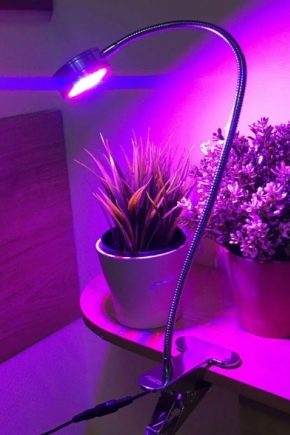
Any plant needs a sufficient amount of light, otherwise it cannot develop normally, this also applies to indoor flowers. In this case, LED lamps are an excellent option in order to create a high-quality light source. The main thing is to know the rules for using this type of lamps.
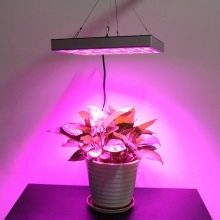


Peculiarities
LED plant lamps compensate for the lack of daylight, which is essential for flowers and photosynthesis. Phytolamps are used both as additional lighting and as one of the options for decorating a room.
Winter is a time of year when people appreciate lush greenery and bloom more, because there are not enough of them on the street. You can easily create an eternal tropical summer in your apartment with LED lights.
They are an excellent light source for plants, but at the same time they remain economical.


Eight pendant lights above a large window, each 36W, provide amazing blooming and growth of plumeria, heliconia, lush ornamental banana palms and other sun-loving tropical plants. It is worth saying that "special" lamps for plants should not be used in everyday life for two reasons. First of all, they are almost 10 times more expensive than conventional LED lights, while such equipment has not been proven to give better results. Plus, not everyone can handle pink / purple light in a living room.
It is enough for the color temperature of the luminaires to reach 6000 K (cool whiteness) - an indicator that is as close as possible to natural daylight.
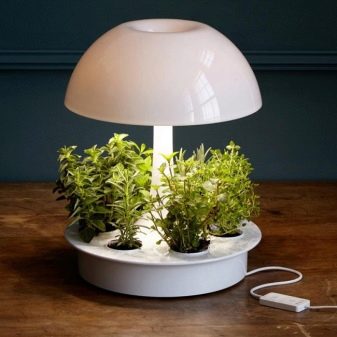
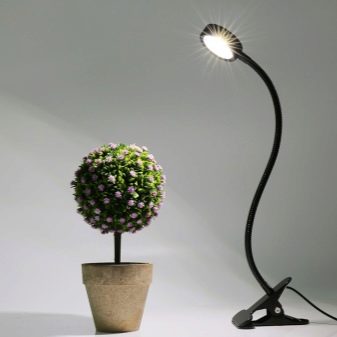
For indoor plants, LED lights are used. They are usually supplied for sale at 400 and 1000 watts. The former provide about 15 square meters of indoor space with daylight. There are models commercially available that allow you to tune the lighting system to provide an optimal spectrum that stimulates plant growth and abundant flowering. This addition provides 17% more spectral energy and 25% more energy in violet, blue and green.
Some models offer a blue-white spectrum which is good for leafy growth. It is most often used as the main light source. One lamp has a capacity of about 10,000 hours.
Red-orange lamps are used to activate the flowering. Of their advantages, one can single out economy, since their average service life is twice as long as that of halogen products. But their main disadvantage is that they do not produce light that falls into the blue spectrum. If such light were the only source for the plant, it would grow with a thin stem.


Advantages and disadvantages
LED lights have already been proven to have health benefits for indoor plants, most of which start to get sick in winter due to lack of lighting. They have many advantages, among which they stand out in particular:
- longest duration of work;
- high efficiency of energy conversion;
- attractive color temperature for the plant;
- radiation is supplied directed;
- completely safe for plants;
- the temperature regime does not change in the room;
- instant start at full potential;
- lack of toxic materials in the composition;
- low operating costs.

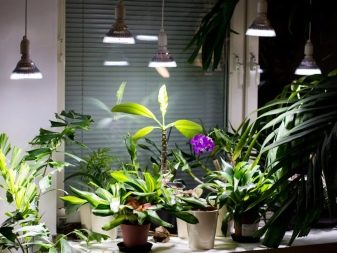
Among the shortcomings, it is necessary to highlight the high cost of such equipment, but given the fact that the lamps consume little energy, you can save on utility bills.

Varieties
There are several varieties of such devices on the market, including a multispectral (multispectral) LED plant lamp. Among them are LED and RGB strip. There are full spectrum patterns or yellow, blue, white, pink. Since each color is responsible for a special effect on the plant, it is worth having in your arsenal such equipment that will be needed at different stages of seedling growth.
Linear diode luminaires have their own classification depending on which spectrum is used:
- red-orange;
- violet blue;
- yellow;
- ultraviolet;
- green.

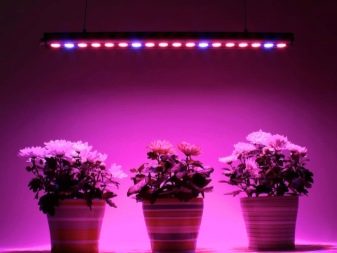
Red and orange have a wavelength in the range of 595-720 nm. Installing them indoors has a positive effect on the process of photosynthesis. Seeds germinate faster, orange spectrum affects fruiting. But if a given color of the lamp is used too often during the flowering period, then the plant's growth can be suppressed.
The violet and blue shades of LED lamps have a wavelength in the range of 380-490 Nm. This spectrum also has a positive effect on the process of photosynthesis, it helps to speed up the process of plant growth. If you use such lighting, then proteins are produced in the cells faster, flowering occurs faster than the established time, which is important with a short daylight hours. Through the influence of the blue spectrum, the root system is formed and strengthened, as well as the crown.

If you want plants not to stretch out in your home garden, then you should use ultraviolet lighting with a wavelength of 280-380 Nm. It is thanks to this spectrum that resistance to sudden changes in ambient temperature is acquired. But the gardener should remember that an excess of ultraviolet radiation kills any plant.
You can also find yellow LED lamps on the market, but they do not have any effect on the growth and development of plants. The same applies to the green spectrum, which has a wavelength between 490 and 565 nm.


Models and their characteristics
There are many Chinese LED lamps on the market that promise gentle home garden care. There are also goods from other countries, including Russian ones. Domestic manufacturers offer models with a control panel of 5 watts or more.
Chiston-S products has a specially selected spectrum, therefore it is used for growing seedlings. It can be installed both as the main light source and as an additional one. The area covered by the light makes it possible to use the equipment not only at home, but also in small greenhouses. The cost of the lamp is only 1100 rubles, which makes the product in demand on the market.
It is necessary to install it from plants at a distance of at least 5 centimeters, the total coverage area is 0.35 sq. m.


Projectors manufactured by under the brand Grow Light... One of their best representatives is the 300W model. In American luminaires of this type, one can distinguish from the advantages a service life of up to 50,000 hours and a coverage area of up to 15 square meters. m. The equipment demonstrates stable operation in a room with an air temperature from -20 to +50 degrees Celsius. The fixture has an improved 12-band full spectrum from UV depth to IR height.


There are other models that you should definitely pay attention to.
- Galaxyhydro LED Grow Plant Light 300w. Size: 12.1 * 8.2 * 2.4 inches. Has a sterilization function. The package includes one LED light, one power cord, one stainless steel hook. The manufacturer gives a 2-year warranty.
- "MarsHydro Mars300 and Mars600". Suitable for beginners looking for an inexpensive fixture. Ideal for seedlings.Shows a balanced spectrum with an emphasis on red light making it ideal for anyone looking for equipment to support flowering.


- KingTM 1200w Power Full Spectrum 360-860 nm. Uses the full spectrum of 360-870 nm sunlight for plants, thereby accelerating growth.
- TaoTronics E27 Growing Lamp 12w. It has 12 LEDs (3 blue and 9 red), ultra bright. It features low power consumption, high luminous efficiency and long service life. These lamps emit light wavelengths of 660 and 430 nm; 630 and 460 nm. The four spectra offer maximum efficiency.


- EcoSuma 120-Degree Beam Angle Big Irradiated Area 12W. It guarantees a fast growth of the plant, which is three times higher than the natural one. Uses the blue and red spectrum, providing precise impact on the seedlings.
- Black Dog Review-PhytoMAX-2 200W: Known to professional gardeners as one of the best brands on the market. Only a few brands can compete with this luminaire in terms of light intensity and quality. The equipment is available in various power settings: 200W, 400W, 600W, 800W, 1000W. The product is made in America, hence the high quality. It is characterized by high light intensity and a broad spectrum that is able to penetrate deep under the crown, providing light to the lower tiers.
Operating temperature range - from -20 to 40 ° C, warranty - 5 years, certificates in ETL, CE, FCC, RoHS. The number of LEDs is 84.


- Bloomspect LED Review-600W. Twice as efficient as other more expensive products with a comparable power source. If the budget is limited, but you do not want to sacrifice efficiency, you can safely consider this option. The lights are available in different power settings: 300W, 600W and 900W. However, only 300W is available with a secondary lens, which increases light penetration and equipment efficiency. All models have full spectrum capability with VEG / BLOOM switch and heat dissipation technology. Offers the brand the optimal amount of blue, red and white spectrum, which are suitable for all types of indoor plants. There are cooling fans in the design. The warranty is 1 year plus 30 days. The luminaire maintains a colder temperature even after 24 hours of continuous operation. It has an average life span of 100,000 hours, uses much less energy and emits much less heat than fluorescent lamps.


Selection Tips
Before purchasing such equipment, you need to carefully consider your lighting needs. There are devices for indoor and aquarium plants, which are presented in a wide range, so choosing is not always easy. One model is suitable for activating the growth of green mass, the other is for maintaining early fruiting, and there are those that are important at the time of flowering.
The type of lighting fixture that will be installed in the greenhouse or at home affects the health of the plants.
- LED lights are ideal for greenhouses as they can provide the necessary spectrum of seedlings that need to be robust.
- LED lamps are much more economical, they convert energy into light in a completely different way, therefore they are popular with professionals.


- Such luminaires demonstrate maximum efficiency, while they do not increase the temperature in the room, so there is no need to install an additional ventilation system.
- Different plants have different lighting and spectrum needs, therefore different options need to be evaluated and choices made based on the conditions that are appropriate for the flowers chosen.
It can be noted that the blue spectrum is suitable for foliage, while the red should be considered for flowers and fruits.
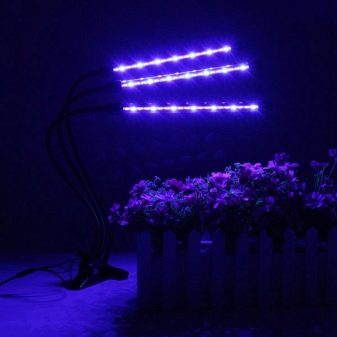

- It is important to pay attention to the voltage, it must be suitable for the network.
- Since LED lamps are practically unstable to heat, an important issue in their relation is the presence of a radiator.It takes over the temperature from the diode block. Often there is no cooling system, and sometimes it is made of plastic. Such options should be left aside, it is better to choose light bulbs with an aluminum ribbed surface.
- The larger the angle of illumination, the better, but the cost of such equipment will be much higher.
- In order not to purchase several separate lamps, experts advise to immediately buy a product with the ability to switch the spectrum.


- You can find models with color rendering on the market. It is necessary to reduce or increase the intensity of the LED bulbs.
- The number of working hours of 50,000 is an average of 15 years. The higher this indicator, the longer the lamp will work.
- Red is the main component that is required to inhibit photosynthesis and stem growth. It signals to the plants that there are no other plantings above it, so they can stretch upward. This is the color that must be present in the lamp. It is desirable that blue also comes with it, since such a combination will allow, in simple words, to grow the plant from seed to the vegetative stage and ultimately to flowering.


The size of the greenhouse or the number of plants will dictate the size and number of LED units that the user purchases. A good rule of thumb for LED luminaires is 32 watts of actual wattage per square meter, assuming that large flowering plants have to be supplied with light. For example, if the space is 15 sq. m, you will have to purchase equipment for at least 500-550 watts, provided that the plants are collected in one place and there are no flowering ones among them, since they require more light. Low-growing plantings, such as grasses, require about 11-18 watts.
If a person grows plants from seedlings for flowers, he needs to buy full spectrum LED equipment. Luminaires designed for high illumination are also available on the market in different versions:
- single-channel;
- two-channel;
- programmable.
The latter are by far the most advanced, since they allow providing quality care throughout the vegetative period.
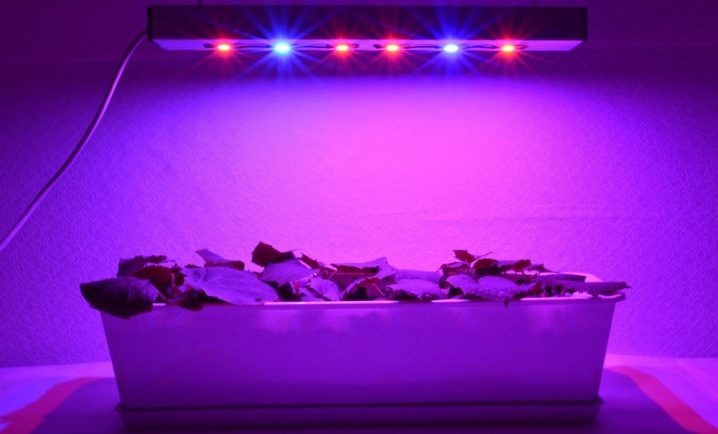
How to use?
It doesn't matter if the flowers are on the windowsill or in the greenhouse, the lighting at home must be designed correctly, only then can we say that the plants receive enough light for growth and flowering. Light is required not only for indoor plantings, but also for aquarium plants, which are also subject to the process of photosynthesis.
Before you start installing LED lights, it will take a little research to determine how much light starvation your plants are. On modern models, you can also set the duration of the lamp and even automate the change of colors in the spectrum.
Red and blue LEDs are a must regardless of the type of plant being grown. Research has shown that the best rate is 80 percent red and 20 percent blue.

Depending on the size and type of plantings, it is worth determining how far the lamps should hang over them. They can be placed both close (minimum distance - 5 centimeters) and far (50 centimeters).
The most important thing is that the plantings are completely covered with light, otherwise there will be no use from such equipment. It is good when there are reflectors in the room, which allow you to distribute the spectrum in such a way that each part of the plant receives the necessary nutrition. As the flowers or seedlings grow and change, the direction of the light will need to be adjusted.
The lamp should not work around the clock, you can turn it off during the day. This may require a timer, but only such equipment is more expensive.It is advisable to set up the supply of additional light on a schedule, if the schedule is violated, this can damage growth. The most difficult thing is to understand whether the plant is experiencing a lack of light and how much to establish the correct regime. In this case, gardeners are advised to pay attention to the intensity of the color and the general condition of the flowers.


There is a special safety precaution, according to which it is forbidden to look at LED lamps, even if it is for a short period of time.
Otherwise, they are safe, but should be kept away from moisture, unless they are special designs made for aquariums.
In the latter case, 10 to 20 lumens are required per liter, although this figure may vary depending on the plant. If they are medium in size, then the parameter increases to 40 lumens per liter of water, which is 1 watt.

For information on how to make LED lamps for plants with your own hands, see the next video.













The comment was sent successfully.